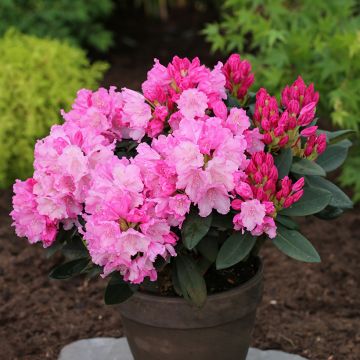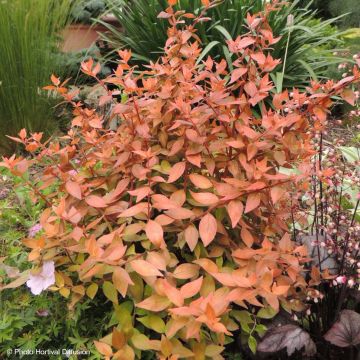

Rhododendron Morgenrot
Rhododendron Morgenrot
Rhododendron yakushimanum Morgenrot
Special offer!
Receive a €20 voucher for any order over €90 (excluding delivery costs, credit notes, and plastic-free options)!
1- Add your favorite plants to your cart.
2- Once you have reached €90, confirm your order (you can even choose the delivery date!).
3- As soon as your order is shipped, you will receive an email containing your voucher code, valid for 3 months (90 days).
Your voucher is unique and can only be used once, for any order with a minimum value of €20, excluding delivery costs.
Can be combined with other current offers, non-divisible and non-refundable.
Home or relay delivery (depending on size and destination)
Schedule delivery date,
and select date in basket
This plant carries a 24 months recovery warranty
More information
We guarantee the quality of our plants for a full growing cycle, and will replace at our expense any plant that fails to recover under normal climatic and planting conditions.
Would this plant suit my garden?
Set up your Plantfit profile →
Description
Rhododendron 'Morgenrot' is a hybrid of small to medium stature, with a compact and rounded habit. Its evergreen foliage is covered with a spring flowering of intense and pure red, so abundant that it is almost indistinguishable. Inside each bell-shaped flower, the red transforms into graceful pink, adorned with a red-brown pattern. This outrageously vibrant bush easily brightens up a small shaded area of the garden, in acid soil.
Rhododendrons are plants from the Ericaceae family, just like heathers, preferring predominantly limestone-free, acid soil and humid climates.
Rhododendron 'Morgenrot' forms a dense bush with a rounded habit, reaching approximately 1.40m in height and 1.30m in width at maturity. Its growth is rather slow. Its small, glossy, evergreen, elliptical leaves cover the plant well. Flowering occurs in May. Grouped in corymbs, the flower buds open into large, 10cm wide, bell-shaped, intense red flowers. The interior of the flower is pink.
Like all yakushimanum hybrids, affectionately known as "rhodos yak" by specialists, Rhododendron 'Morgenrot' is hardy down to -15°C or even -20°C. Although they prefer partial shade, these hybrids can tolerate sun as long as it is not scorching (morning sun) and their base remains cool. 'Morgenrot', with its abundant and brightly coloured flowering, easily dresses up a small, slightly shaded area of the garden, alongside ferns, blue or variegated hostas, Pieris, Azaleas, and Japanese Maples, or other rhododendrons from the same group to create stunning patchworks of textures and colours in spring. Cultivation in pots requires regular watering with non-limestone water, as well as specific fertiliser for acid-loving plants.
Report an error about the product description
Rhododendron Morgenrot in pictures




Plant habit
Flowering
Foliage
Botanical data
Rhododendron
yakushimanum
Morgenrot
Ericaceae
Cultivar or hybrid
Other Small Rhododendron
View all →Planting and care
Plant Rhododendron 'Morgenrot' in a partially shaded position, protected from cold and drying winds, in a moist, humus-rich and light soil, with a tendency towards acidity (pH between 4.5 and 6). Like all plants that prefer acid soil, it cannot tolerate chalky soils, drought, heatwaves, or heavy waterlogged soils in winter. If the soil remains moist in summer, this rhododendron can also tolerate exposure to non-scorching sunlight.
Dig a hole three times larger than the pot. Soak the root ball in non-chalky water and plant the bush at the collar level, in a mixture composed of 1/4 ericaceous soil, leaf compost, gravel or volcanic rock, and loam. Water generously and keep the soil moist in summer. Azaleas and Rhododendrons have a shallow root system, so they are susceptible to long periods of drought. That's why it is recommended to enrich the soil with organic matter and water abundantly during dry periods. Additionally, their root system is not very strong, which is why it is essential to lighten heavy soils with drainage materials (gravel, volcanic rock, clay pellets) at planting. Apply a mulch of shredded pine bark around the base of the bush every spring to maintain soil moisture and acidic pH.
Maintenance involves removing faded flowers in summer and cleaning out dead branches. Azaleas and Rhododendrons can sometimes be attacked by vine weevils, which eat the edges of leaves and rootlets, as well as the notorious 'rhododendron beetle', which rarely causes significant damage. Effective organic solutions are now available to control vine weevils. Yellowing of leaves (chlorosis) in Rhododendrons indicates poor assimilation of iron in the soil and can lead to premature death of the plant. While limestone (in the soil or irrigation water) is often the cause, poorly drained soil or deep planting can also contribute to this phenomenon.
Planting period
Intended location
Care
This item has not been reviewed yet - be the first to leave a review about it.
Similar products
Haven't found what you were looking for?
Hardiness is the lowest winter temperature a plant can endure without suffering serious damage or even dying. However, hardiness is affected by location (a sheltered area, such as a patio), protection (winter cover) and soil type (hardiness is improved by well-drained soil).

Photo Sharing Terms & Conditions
In order to encourage gardeners to interact and share their experiences, Promesse de fleurs offers various media enabling content to be uploaded onto its Site - in particular via the ‘Photo sharing’ module.
The User agrees to refrain from:
- Posting any content that is illegal, prejudicial, insulting, racist, inciteful to hatred, revisionist, contrary to public decency, that infringes on privacy or on the privacy rights of third parties, in particular the publicity rights of persons and goods, intellectual property rights, or the right to privacy.
- Submitting content on behalf of a third party;
- Impersonate the identity of a third party and/or publish any personal information about a third party;
In general, the User undertakes to refrain from any unethical behaviour.
All Content (in particular text, comments, files, images, photos, videos, creative works, etc.), which may be subject to property or intellectual property rights, image or other private rights, shall remain the property of the User, subject to the limited rights granted by the terms of the licence granted by Promesse de fleurs as stated below. Users are at liberty to publish or not to publish such Content on the Site, notably via the ‘Photo Sharing’ facility, and accept that this Content shall be made public and freely accessible, notably on the Internet.
Users further acknowledge, undertake to have ,and guarantee that they hold all necessary rights and permissions to publish such material on the Site, in particular with regard to the legislation in force pertaining to any privacy, property, intellectual property, image, or contractual rights, or rights of any other nature. By publishing such Content on the Site, Users acknowledge accepting full liability as publishers of the Content within the meaning of the law, and grant Promesse de fleurs, free of charge, an inclusive, worldwide licence for the said Content for the entire duration of its publication, including all reproduction, representation, up/downloading, displaying, performing, transmission, and storage rights.
Users also grant permission for their name to be linked to the Content and accept that this link may not always be made available.
By engaging in posting material, Users consent to their Content becoming automatically accessible on the Internet, in particular on other sites and/or blogs and/or web pages of the Promesse de fleurs site, including in particular social pages and the Promesse de fleurs catalogue.
Users may secure the removal of entrusted content free of charge by issuing a simple request via our contact form.
The flowering period indicated on our website applies to countries and regions located in USDA zone 8 (France, the United Kingdom, Ireland, the Netherlands, etc.)
It will vary according to where you live:
- In zones 9 to 10 (Italy, Spain, Greece, etc.), flowering will occur about 2 to 4 weeks earlier.
- In zones 6 to 7 (Germany, Poland, Slovenia, and lower mountainous regions), flowering will be delayed by 2 to 3 weeks.
- In zone 5 (Central Europe, Scandinavia), blooming will be delayed by 3 to 5 weeks.
In temperate climates, pruning of spring-flowering shrubs (forsythia, spireas, etc.) should be done just after flowering.
Pruning of summer-flowering shrubs (Indian Lilac, Perovskia, etc.) can be done in winter or spring.
In cold regions as well as with frost-sensitive plants, avoid pruning too early when severe frosts may still occur.
The planting period indicated on our website applies to countries and regions located in USDA zone 8 (France, United Kingdom, Ireland, Netherlands).
It will vary according to where you live:
- In Mediterranean zones (Marseille, Madrid, Milan, etc.), autumn and winter are the best planting periods.
- In continental zones (Strasbourg, Munich, Vienna, etc.), delay planting by 2 to 3 weeks in spring and bring it forward by 2 to 4 weeks in autumn.
- In mountainous regions (the Alps, Pyrenees, Carpathians, etc.), it is best to plant in late spring (May-June) or late summer (August-September).
The harvesting period indicated on our website applies to countries and regions in USDA zone 8 (France, England, Ireland, the Netherlands).
In colder areas (Scandinavia, Poland, Austria...) fruit and vegetable harvests are likely to be delayed by 3-4 weeks.
In warmer areas (Italy, Spain, Greece, etc.), harvesting will probably take place earlier, depending on weather conditions.
The sowing periods indicated on our website apply to countries and regions within USDA Zone 8 (France, UK, Ireland, Netherlands).
In colder areas (Scandinavia, Poland, Austria...), delay any outdoor sowing by 3-4 weeks, or sow under glass.
In warmer climes (Italy, Spain, Greece, etc.), bring outdoor sowing forward by a few weeks.


















































